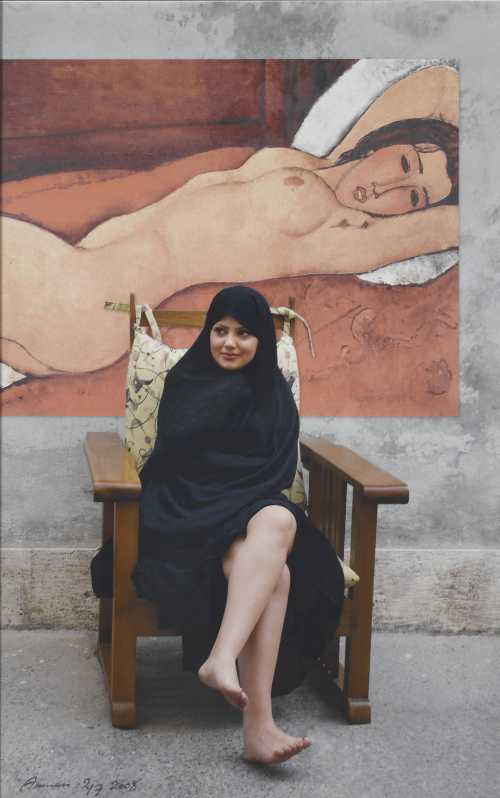About Arman Estepanian
Arman Stepanian, a researcher, graphic artist, and photographer of Armenian descent, was born in Abadan. Stepanian began his art studies in graphics at the Faculty of Fine Arts in Tehran. His collection of photos in 1999 from the Armenian cemetery of Sar Asiyab brought him fame and his entry into the professional field of photography. In 2002, the first solo exhibition of his photographs was held at the Sofitel Gallery in Luxembourg, and in the same year, his photographs were exhibited individually at the Seyhoun Gallery in Tehran. He has also participated in numerous domestic and foreign group exhibitions; Exhibitions in domestic galleries such as Homa, Khak, Laleh, and Seyhoun and galleries in Paris, Greece, Cyprus, Dubai, New York, Vienna, and Toronto are among them. Stepanian has a special diploma from the jury of the first and second biennial of Iranian graphics in 1986 and 1988. In 1995, he also won an honors diploma from the Art and Prayer Festival.
Stepanian was very interested in the history of photography in Iran, and the importance of Armenians in this history was another link to make him do research and analysis in this field. In 1990, he collected photos taken from the Qajar period onwards of the Armenians of Iran and displayed a collection of 210 pieces of photos in the Tehran Museum of Contemporary Arts titled "Looking at the history of Iran, the Armenians of Iran through the lens of a camera." This desire for historical progress led him to Antoine Suryugin, known as Antoine Khan. Antoine Khan was one of the most famous photographers of the Naseri period and served the first Pahlavi. Stepanian did detailed research about this photographer and collected his photos, which were exhibited in France and Iran in 2002 with the cooperation of the Tehran Museum of Contemporary Art and Paris Municipality.
Stepanian's historical desire and retrospection are also reflected in his own photos. Obsolescence, wear and tear, destruction, and everything that shows signs of time are integrated into Stepanian's photos. He sometimes collects old and anonymous family photos and uses techniques such as photo collages to put them in the frames of his works. The sense of nostalgia and longing for the past has left its stamp on most of Stepanian's photos. In the pictures he took from the Armenian cemetery of Doulab, he makes the ruined tombstones with faded faces imprinted on them as the subject of his photo, emphasizing the same point of view. Stepanian's scattered paintings also follow the same rule. In some of his paintings, he goes to the Qajar harem's women, recreating them with a mood similar to the photos Suryugin took of the interior.
The Most Expensive Artwork
At Auctions
First Attendance
11 May 2010
# Attendance
15
# Artworks
24
Average Realized Price
5,012 USD
Average Min Estimate
3,287 USD
Average Max Estimate
4,413 USD
Sell-through Rate
41.667%
Average Growth of Artwork Worth
29.325%
Timeline
The 21st Tehran - Contemporary Iranian Art auction
11 October
10s of Artworks, 10s of Millions exhibition
8 March
Woman exhibition
13 December
Tehran- 16th- Iranian contemporary art auction
1 July
Magic Returns auction
30 June
Half exhibition
4 March
The last event 1400 exhibition
25 February
The First Fertile Element exhibition
18 February
PREMIER ARTS - DESIGN - MODERN AND CONTEMPORARY TABLES auction
25 June
Roots from the Sky exhibition
25 December
Vente publique auction
17 September
Photographies auction
25 April
+۹۶ exhibition
16 February
In the realm of light exhibition
11 August
"Still Life" Amordad Annual exhibition
4 August
Gentle Land exhibition
2 December
Islamic and Indian Art auction
8 April
دومین دوره حراج تهران auction
28 May
Collage Tales exhibition
10 September
اولین دوره حراج تهران auction
22 May
Visions d'Orient - De l'orientalisme à l'art contemporain auction
4 November
Contemporary Art / Arab & Iranian auction
4 October
Arman Stepanian Artworks Viewing exhibition
22 April
Photographs and Orientalist Art auction
13 April
Hurouf: The Art of the Word auction
16 December
Contemporary Art / Arab & Iranian auction
20 October
Modern and Contemporary and Latin American Art auction
11 May
Arman Stepanian Photos exhibition
30 April
Arman Stepanian Photography exhibition
26 February
